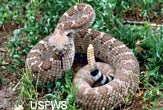Rattlesnakes Grow While Starving

Even when they are starving rattlesnakes grow, eating themselves from within to gain length while reducing girth.
This finding goes against previous reports that reptiles shrunk during lean times, as would be expected.
The western diamondback rattlesnake can go two years without food. Marshall McCue of the University of Arkansas studied 16 of the venomous creatures for 168 days, or more than five months.
Snakes starved for the entire period fed on their own stores, converting protein to carbohydrates. Calcium amounts doubled.
"Because it takes more energy to grow than to eat yourself, the snake changes shape by reducing its girth and putting its resources into skeletal muscles and bone," McCue said this week at a meeting of the American Physiological Society. "It isn't panicking."
The study supports a longstanding hypothesis that a snake's length correlates with physiological fitness, McCue said.
Fatty acids also increased as the snakes fasted. Over time, however, hydrogen was drawn from the fatty acids as an energy source.
Sign up for the Live Science daily newsletter now
Get the world’s most fascinating discoveries delivered straight to your inbox.
McCue's work could point toward ways to manipulate human diets.
"We might be able to engineer diet so animals, and say humans in space, can tolerate food-deprivation better," he said.
- Gallery: Snakes of the World
- Flying Snakes: New Videos Reveal How They Do It
- The New Odd Couple: Snake and Hamster Make Friends
- Frogs Hatch Earlier to Escape Snacking Snakes
- Python Eats Pet Cat in Florida
Robert is an independent health and science journalist and writer based in Phoenix, Arizona. He is a former editor-in-chief of Live Science with over 20 years of experience as a reporter and editor. He has worked on websites such as Space.com and Tom's Guide, and is a contributor on Medium, covering how we age and how to optimize the mind and body through time. He has a journalism degree from Humboldt State University in California.










